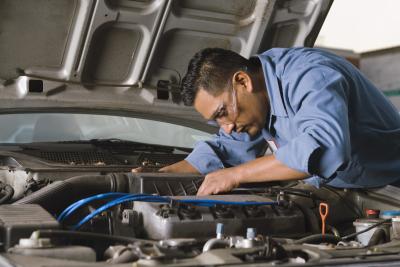
Rebuilding or "blueprinting" an engine can help you restore factory performance and reliability for far less than a new engine would cost. However, a good rebuild can costs thousands of dollars, even when the work is done at home. Also, a rebuild isn't a magic bullet by any means; it won't solve all of an engine's woes.
The first step (and possibly the most important one) in rebuilding an engine involves taking it apart. No matter how eager you are to dig in and start replacing parts, you should always use a careful and systematic approach when disassembling the engine. Think of disassembling as an autopsy or exploratory surgery; every little irregularity is a clue to diagnosing the condition of major components like crankshafts, engine blocks and heads.
Pay close attention to bearing wear and debris in the engine. Bearing wear should not extend any farther than the copper lining. Wear past that point is a very good indication of crank-shaft damage. Any kind of metal debris in the oil pan should be investigated to determine whether the block or heads have suffered major damage.
This step separates a professional rebuild from a backyard hack job. Although bearings, piston rings and wear components are designed to wear out before larger, more expensive parts like crankshafts and blocks, some wear on the larger components should be expected. Measure the diameter of major components with a set of dial calipers, and compare the measurements against your engine's original specifications. Doing this lets you know whether your engine needs machining or whether you should install oversized pistons, piston rings and bearings.
PlastiGauge makes a great tool for checking your tolerances and clearances, but using it effectively requires some practice. You put this waxy strip between bearings and components during the measuring phase, and it flattens out by a precise amount to indicate the amount of bearing clearance. Have an experienced friend help you the first couple of times you use PlastiGauge, since a mistake here can cost big bucks down the road.
If your cylinder walls, main bearings, rods or crankshaft are damaged or out of spec, then you need to have the parts machined back into shape. Machinists not only can make damaged parts round again, but they also can use a milling machine to flatten the block-to-head mounting surface on the block and cylinder heads. Extensive machine work can be an expensive and lengthy proposition.
When the parts have been machined back into their proper tolerances and all the clearance-adjusted replacement bearings, pistons and rings are sitting on your workbench, you reach the easy part: putting the engine back together. Take your time, and follow the exact assembly procedures advised for your specific engine. Always use molybdenum-based assembly lube on your new bearings and wear surfaces when assembling the engine. The heavy engine oil often used by backyard mechanics does not permit proper break-in of bearings and parts. And whatever you do, DO NOT forget to prime your oil pump before starting the engine.